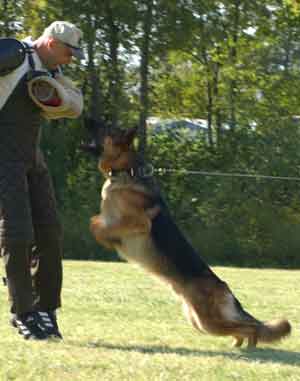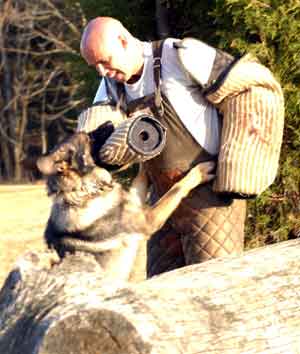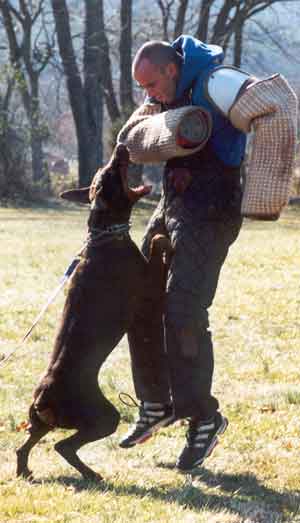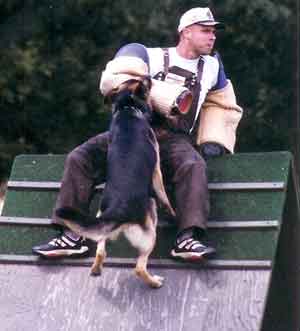Two Sides to Everything
by Armin Winkler
A good foundation is where everything starts. I've covered foundation topics over the past few months and looking back, I think I missed something. The reason for that is probably because what I will discuss in this article may not become an issue until later in a dog's career. But I think it should be addressed as part of the dog's foundation training. What am I talking about? I'm talking about the "other side," of course.
 Regardless of whether we are right- or left-handed, we all perform certain tasks a certain way. We get used to doing it like that and feel quite
awkward when things are not the way we expect them. For example, all our cars are left hand drive. We are used to sitting on the left side of a car
while driving and never give it a second thought. Has anybody ever driven in a right hand drive car? It feels weird to say the least. That's one example
of course, there are a million things we do every day that we are used doing from one side.
Regardless of whether we are right- or left-handed, we all perform certain tasks a certain way. We get used to doing it like that and feel quite
awkward when things are not the way we expect them. For example, all our cars are left hand drive. We are used to sitting on the left side of a car
while driving and never give it a second thought. Has anybody ever driven in a right hand drive car? It feels weird to say the least. That's one example
of course, there are a million things we do every day that we are used doing from one side.
Dogs get used to doing things a certain way just like we do. They develop techniques and habits during training. Sometimes the habits that develop in training are very one sided. Let me run through some areas where I have noticed this and offer some suggestions to ensure it won't lead to problems down the road.
The Frontal Strike
All frontal strikes in a Schutzhund trial are essentially the same as far as technique is concerned -the attack on handler exercise in SchH 1, the surprise attack from the rear transport in SchH 2 and 3, and the courage test in all levels. There are two ways a dog can be caught when performing a frontal strike: to the sleeve side, or to the stick side. I'm staying away from right or left here, because it doesn't matter on which side the helper wears the sleeve.
 As helpers we all have a preferred side. Well, guess what, so do the dogs. I really noticed this a few years ago,
when catching some faster dogs who had their preferred side opposite to mine. Not a pretty sight. I ended up bending and contorting to avoid
jamming the dog. The first thought I had was, "I screwed that up." We tried it again and experimented around a bit, and it turned out that I was not the
only one screwing it up. The dog did too. Now you may say, "so catch the dog to the other side then." That certainly is a solution for the moment.
But the problem goes deeper. The problem is that dogs do learn a preferred technique. They learn to come to one side and only one side when they strike.
Some dogs have this so ingrained in them that they simply cannot be caught to the other side. In a trial the timing between helper and dog is a matter of a
second or two; in this time, we have to make sure we are set up to catch the dog safely without hurting him and we have to decide which side to catch him
to and do all this without falling flat on our butts in the process. Most high-level competition dogs have this bug worked out, and most high-level competition
helpers have learned to compensate for the few who don't. But nobody starts at high-level competition.
There is a road that has to be traveled to get there. And the road benefits the helper as well as the dog.
As helpers we all have a preferred side. Well, guess what, so do the dogs. I really noticed this a few years ago,
when catching some faster dogs who had their preferred side opposite to mine. Not a pretty sight. I ended up bending and contorting to avoid
jamming the dog. The first thought I had was, "I screwed that up." We tried it again and experimented around a bit, and it turned out that I was not the
only one screwing it up. The dog did too. Now you may say, "so catch the dog to the other side then." That certainly is a solution for the moment.
But the problem goes deeper. The problem is that dogs do learn a preferred technique. They learn to come to one side and only one side when they strike.
Some dogs have this so ingrained in them that they simply cannot be caught to the other side. In a trial the timing between helper and dog is a matter of a
second or two; in this time, we have to make sure we are set up to catch the dog safely without hurting him and we have to decide which side to catch him
to and do all this without falling flat on our butts in the process. Most high-level competition dogs have this bug worked out, and most high-level competition
helpers have learned to compensate for the few who don't. But nobody starts at high-level competition.
There is a road that has to be traveled to get there. And the road benefits the helper as well as the dog.
We teach the dog how to perform a frontal strike. So it only stands to reason, that we should make sure that we teach it in a complete way with no problems to come up later. As helpers we naturally have to hone our own mechanics in a way that we are physically capable of catching dogs to both sides. The decision as to which side has to be made ahead of time, so we avoid just "winging it." Set the strikes up short and use dogs that allow a catch to both sides. And practice. Something I like to do with helpers who are just learning is to have them catch dogs with just a puppy tug. The thing the helper has to learn is to absorb to both sides and set the dog on the ground. This can easily be done with the tug. It is a lot of fun for the dog, and he doesn't get jammed while the helper is practicing. The footwork rule is the same for tug and sleeve. When catching to the left, the right foot has to be set forward. When catching to the right, the left foot has to be planted forward. This allows a smooth pivot at the hip to absorb and direct the dog's weight. Once the mechanics are good, we can start to use them for young dogs who are just learning. Again, I would suggest using a tug in the beginning and to alternate sides with each catch. Naturally, this has to be practiced with a sleeve as well. If the dogs learn it like that, they will commit more to the center of the helper's body, and they will allow the helper to catch them to either side. So if the dog encounters a helper who is very determined to catch to only one side, it won't cause problems or lead to injury for your dog.
The Sleeve Arm
Another area where the training may be a bit "one sided" is the side the sleeve is worn on to begin with. Most right handed helpers wear the sleeve on the left arm. But there are helpers who do wear the sleeve on the right. This is a bigger deal for the dog than people may think. The whole trial routine looks different for the dog. Some exercises where the dog will show some reaction to the sleeve being on the "wrong" side and which are relatively simple to incorporate into training are the hold and bark, the re-attack from the guard, and again the frontal strike. Also being driven on the right side after any of the initial bites is a very new picture for the dog.
The Hold and Bark
I would say that the easiest exercise to practice with an arm on the right is the hold and bark. It does not involve a lot of mechanics from the helper. The picture of the helper with the sleeve on the left is a familiar one. The dog gets used to setting himself up a certain way, and he settles into a hold and bark. Change the picture, and it will unsettle the dog. The whole set up for success the dog has learned is off. Try it in your own club, watch the look of confusion on many dogs faces when they first arrive. Depending on the quality of the dog and his experience level, there will be differences. But if it is the first time the dog sees the sleeve on the right there will be a reaction. I wouldn't want him to see it for the first time at a club I'm visiting for a first time trial. It is relatively easy to work this into regular training. Many clubs have an ambidextrous sleeve sitting in their equipment shed, or if not, then they should invest in one; or stuff a few old sleeve covers inside each other and use that — that allows enough protection and can be worn on either side.
The Re-Attack
 The next exercise that should be practiced is the re-attack from the hold and bark or guard. Again, the dog has a certain way to set up on his favorite
side for the guard, and expects the attack to look a certain way. There is quite a bit of technique involved for the dog to come out of the guard and target the
sleeve well on a helper who is attacking towards him. After all, the dog is only inches from the helper. You will notice that the dogs require a considerable
amount of practice to have the same skill and technique when the direction of the attack is reversed. Again, this is a short move and we can use "make-do"
equipment to at least expose the dog to the picture. The helper has to work on his mechanics to coordinate moving the stick and setting the sleeve, but that
should be fairly simple. The key is to incorporate this into training enough to make sure the dog learns to accept this picture from both sides.
Once the dog is trained totally one sided, it becomes much harder to get him to accept a change.
The next exercise that should be practiced is the re-attack from the hold and bark or guard. Again, the dog has a certain way to set up on his favorite
side for the guard, and expects the attack to look a certain way. There is quite a bit of technique involved for the dog to come out of the guard and target the
sleeve well on a helper who is attacking towards him. After all, the dog is only inches from the helper. You will notice that the dogs require a considerable
amount of practice to have the same skill and technique when the direction of the attack is reversed. Again, this is a short move and we can use "make-do"
equipment to at least expose the dog to the picture. The helper has to work on his mechanics to coordinate moving the stick and setting the sleeve, but that
should be fairly simple. The key is to incorporate this into training enough to make sure the dog learns to accept this picture from both sides.
Once the dog is trained totally one sided, it becomes much harder to get him to accept a change.
The Frontal Strike
The frontal strike is a difficult exercise for any helper to begin with, never mind trying to do it on the side that we are not really comfortable on. Many clubs don't have the luxury to have at least one helper in the club who is left handed and wears a right sleeve. So the options are much more limited. Under no circumstances should we risk injury to either dog or helper. The only option you may have is to travel to a club to work on a helper who can catch on the right or attend a seminar with someone who does. I found that in the strike the dogs don't show the effect of the different side presentation as much, since there is a certain amount of triggering by the helper involved anyway. For dogs who are heading to big competitions where a helper who uses a right sleeve may be a possibility, I would say some exposure is a must. But that does not happen often enough to warrant taking risks.
 It is something every helper has to decide for himself if he wants to give it a try and be able to help his club dogs deal with this difficulty.
But do it carefully and safely. All-out courage tests are not required here. All it takes is for the dog to see the sleeve on the other side and
learn that he can enter as he always does. I am talking about exposure nothing more. Keep it short, and practice with the sleeve well presented for targeting,
the dog will do the rest. Once a dog has done it a few times, it seems not to interfere with their normal striking technique in the least.
It is something every helper has to decide for himself if he wants to give it a try and be able to help his club dogs deal with this difficulty.
But do it carefully and safely. All-out courage tests are not required here. All it takes is for the dog to see the sleeve on the other side and
learn that he can enter as he always does. I am talking about exposure nothing more. Keep it short, and practice with the sleeve well presented for targeting,
the dog will do the rest. Once a dog has done it a few times, it seems not to interfere with their normal striking technique in the least.
The Right-Side Drive
Finally, there is the driving the dog. This takes quite a bit of coordination from the helper if he is not used to working on the right. It is particularly important for dogs who have shown grip deterioration during the drive in the past. Most of the time the cause for this grip problem is the helper - dog conflict (Getting a Grip). And since it is the helper who is the cause, anything the helper does can be a factor. We teach the dog how to deal with the pressure he faces during a drive and get him to overcome the problem. But in order to do that the dog has to be confronted with the pressure in order to learn handling it. So it only stands to reason that the dog has to be exposed to being driven on the right so he can learn to handle the stress he faces during this exercise.
 As helpers, we have to first learn the mechanics how to drive a dog on the right. The optimal way to learn is to practice on dogs who are very solid and
who allow themselves to be driven. It is easy to trip and stumble in the beginning, so having to really fight a dog is not optimal. Start slowly with a slow skip
drive, and increase the speed as coordination improves. The running drive should be left until later, as it requires more speed and coordination. Once the helper
has the technique to drive a dog on the right, he has to start teaching the dogs in training to deal with being driven on the right. So again things have to be slowed
down to expose the dog to the picture of being driven on the right, without having to face the pressure of speed and intensity. As in driving a dog on the familiar side,
we can't teach when we are out of control, so we have to be able to increase or decrease our speed and intensity as the dog allows us to.
As helpers, we have to first learn the mechanics how to drive a dog on the right. The optimal way to learn is to practice on dogs who are very solid and
who allow themselves to be driven. It is easy to trip and stumble in the beginning, so having to really fight a dog is not optimal. Start slowly with a slow skip
drive, and increase the speed as coordination improves. The running drive should be left until later, as it requires more speed and coordination. Once the helper
has the technique to drive a dog on the right, he has to start teaching the dogs in training to deal with being driven on the right. So again things have to be slowed
down to expose the dog to the picture of being driven on the right, without having to face the pressure of speed and intensity. As in driving a dog on the familiar side,
we can't teach when we are out of control, so we have to be able to increase or decrease our speed and intensity as the dog allows us to.
Conclusion
This article is based on my observations. Over the years I've dealt with injuries and sometimes my arm just got tired, so I put a sleeve on the other side. The difference it made to me and the dogs had an impact on me. I've always had ambidextrous equipment around, and I've used it too. But never as deliberately as in the last few years. Working dogs that were better than my abilities showed me that I have to work on myself too, to keep up with the dogs. Making sure that my limitations as a helper don't become the dogs' limitations in their sport careers. Those were the things that made me work on catching to both sides, and using sleeves on both sides. I thank the people and dogs who allowed me to work on myself, and hope that I can repay it now by helping dogs to be better prepared on the field.
The point of the article is as always to highlight an observation that I feel has importance in training. By sharing information and ideas training continues to get better. People share their dogs with me by bringing them to the field. I like to share what I learn from them by writing about it.
